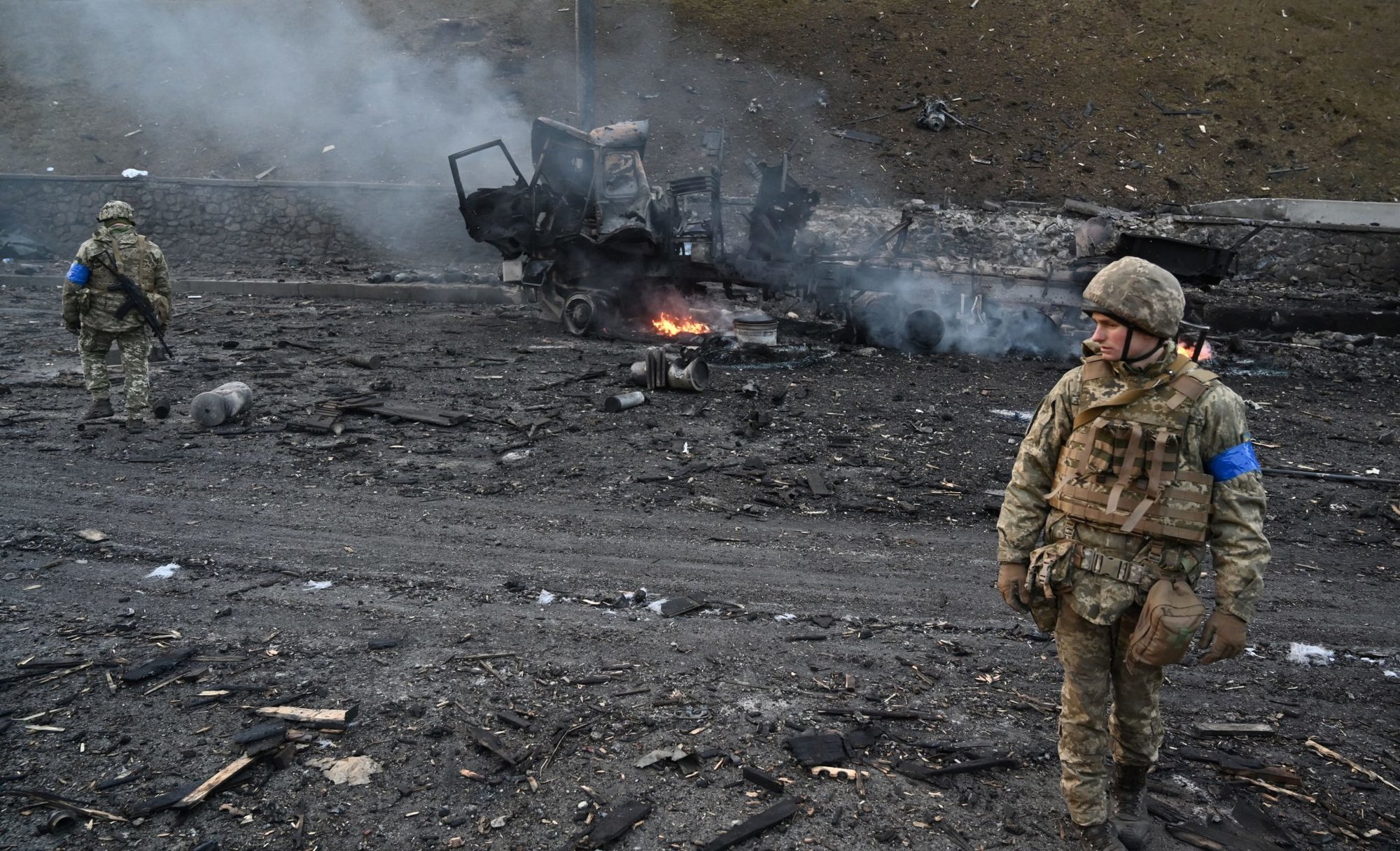
Ukrainian service members look for unexploded shells after fighting with a Russian raiding group in the Ukrainian capital of Kyiv in the morning of Feb. 26, 2022, according to Ukrainian service personnel at the scene. Photo by Sergei Supinsky/AFP via Getty Images.
The night was cold, the jet noise was loud, and an emotional charge was in the air — like an electric current about to arc. A cargo door opened on the side of the Boeing 747, and workers raised a lift to the jumbo jet’s level. Then, like a star athlete dramatically emerging onto the playing field, the first cargo pallet emerged. Then another. And another and another.
Down on the tarmac, a crowd of journalists pressed forward against a barrier. We all hoped to observe what this aircraft, which had traveled halfway around the world from America, had delivered to Kyiv’s Boryspil Airport.
To be honest, the unloading process wasn’t all that impressive. No more notable of a sight, in terms of outward appearance, than anything you might see on the tarmac of any airport around the world on any given day. Just cargo pallets containing bundled-together green crates. Nothing suggested the lethal potential of this cargo. Clues to the delivery’s symbolic value, however, were less elusive.

Dear reader, I wish you could have been there that night, before the Russians invaded, to feel what it was like to watch those 300 Javelin anti-tank missiles emerge from the belly of that giant Boeing jet. Even more, I wish you could have seen for yourself the proud looks on the faces of all the Ukrainian journalists who stood beside me. You would have been particularly proud to be an American that night, had you been there. I know I was.
While the pallets of Javelin missiles accumulated on the tarmac, a Ukrainian journalist named Yuriy turned to me and put a hand on my shoulder and said, “It’s nice to know we’re not alone.”
In his book, Into Thin Air, which describes his personal experiences during the 1996 Mount Everest mountaineering disaster, Jon Krakauer writes: “I agree that readers are often poorly served when an author writes as an act of catharsis, as I have done here. But I hoped something would be gained by spilling my soul in the calamity’s immediate aftermath, in the roil and torment of the moment.”
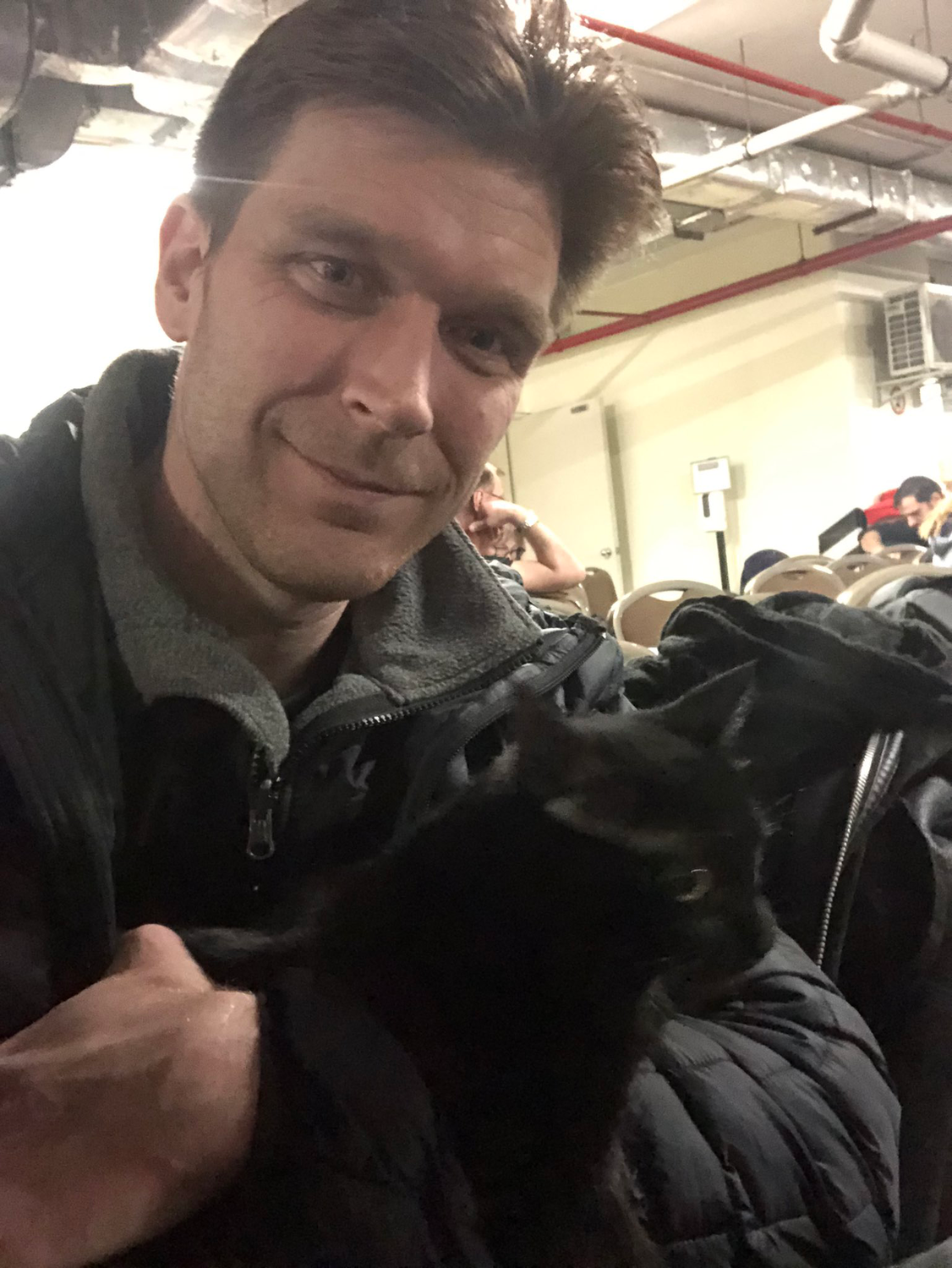
I’m writing these words neck-deep in the moment, and Ukraine’s fate is far from certain. For months, Russia massed its military forces on Ukraine’s borders while consistently denying its intention to invade. Now, the storm has arrived, and a full-scale Russian invasion bears down on a nation that did not ask for violence and did not ask for lethal missile bombardments that have killed scores of civilians.
Today, Russian forces have encircled and are ready to lay siege to the capital city of Kyiv — home to some 3 million to 4 million people.
Maybe you can’t see the threat from your vantage point, dear reader. Maybe this war seems too distant to disrupt or destroy a life you care about. Whether you believe it or not, what you are seeing on TV and social media may be the beginning of America’s next war.
For nearly eight years, my adopted hometown of Kyiv remained relatively quarantined from the physical effects of daily combat some 400 miles away in Ukraine’s eastern Donbas region. The war’s physical dangers had long been confined to a swath of territory along the contact line that extended only as far as the range of the weapons used. In short, the war became a destination; once you were at it, you were in it. Yes, it was common to see soldiers on Kyiv’s streets. And, from time to time, sidewalk displays reminded people about the conflict’s ongoing toll. The war had always been there, but clues to its existence were often subtle and easily overlooked in this bustling, up-and-coming metropolis — the “New Berlin,” as many residents of Kyiv liked to say.

At first, many Ukrainians were skeptical about the possibility of a Russian re-invasion this winter. But the mood shifted in the weeks leading up to the onslaught, with many people believing a wider war was genuinely possible.
Many Ukrainians faced tough choices — especially parents. Some people chose to leave, heading to the western part of the country or abroad. Some chose to stay and stockpile supplies to weather a Russian siege. Many attended crash-course military training programs to prepare for fighting Russians street by street. It seemed like the opening scenes of a World War II film at times. Except it was not some Hollywood interpretation of history — these historic events are happening right now, in our time.
Before the Russians invaded, the mood here in Kyiv approximated that of any Florida town or city in the days before a hurricane. Those final days before the storm are often clear and calm and offer little evidence of the invisible danger lurking over the horizon. Yet, you understand how quickly the present lull can turn to tempest, and so you must decide, while there is still time, whether to stay or flee. But it’s important to note that a hurricane is an act of God. This invasion was a choice. And it is a crime.
Yet, there was no sense of panic or outright anxiety in Kyiv or across Ukraine. This country had already been at war for eight years, remember. And Ukrainians are not a people to scare easily or wear their emotions on their sleeves.
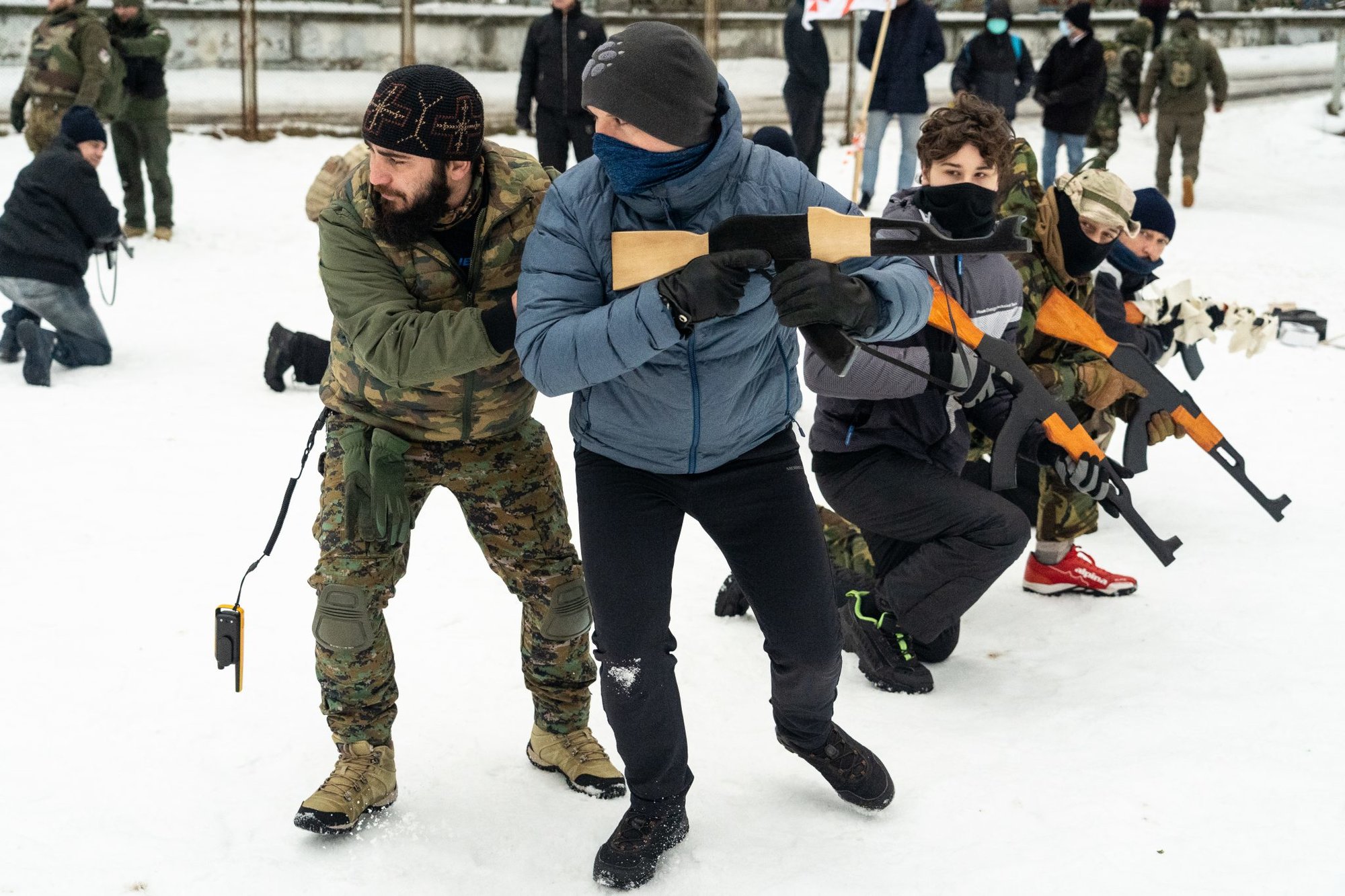
By the end of Ukraine’s Revolution of Dignity in February 2014, sections of Kyiv had turned into de facto combat zones. Eight years later, bullet holes still scarred light poles and a stone wall at the place where snipers gunned down protesters during the revolution’s final days. This unfaded evidence of past violence reminded us all how thin the veneer of civilization truly is — and how quickly things can fall apart. Even so, walking around Kyiv, it was hard to take seriously the notion that this vibrant European capital would soon be besieged.
With Russian military forces massed on Ukraine’s borders, Kyiv’s buffer from the war — in terms of physical distance and emotional immediacy — was rapidly dissolving for many of the city’s civilians. Adding to the spectacle, a tsunami of foreign journalists descended upon Ukraine. Even though Europe’s only ongoing land war had simmered for nearly a decade, the stalemated trench combat in the Donbas had, until this winter, dropped from most global headlines.
The cottage industry of local fixers and producers had been semi-dormant since the war’s most active years in 2014 and 2015 but were reemerging in force to accommodate hordes of foreign journalists queuing up for trips to the Donbas front lines like tourists waiting for a ride at Disney World. The global media presence at weekend training sessions for Kyiv’s Territorial Defense Force units resembled a red-carpet paparazzi scrum.
Apart from the media circus, life appeared to be going on as usual in Kyiv and across Ukraine. But when you asked people how they felt without shoving a camera in their faces, many said they were genuinely concerned about what could happen.
How many children had to hug their father one more time, then leave him behind at the train station as Russian missiles rained down on the city?
During the months leading up to the invasion, I often used the word limbo to describe life here in Ukraine. That word applied to civilians and the roughly 430,000 Ukrainian veterans of the Donbas war. Many belonged to Ukraine’s first operational reserve, who could be recalled to active-duty service within 24 hours. Coming home from war is hard on any man or woman who has served — especially when your war isn’t over. Ukrainian veterans carried the added burden of knowing that, on 24 hours’ notice, they could be ordered to kiss their families goodbye, throw on a uniform, grab a gun, and stare down a Russian invasion force. They didn’t know it then, but that’s exactly what they would do.
“I’m going to resist, definitely. Like many veterans, my military bag is already packed, and we constantly coordinate our efforts,” Maria Berlinskaya, a Ukrainian veteran of the war in the Donbas, told me. “We know that we will fight for freedom by ourselves, and we consider that it’s our duty to protect not only our country but all the Western world.”
The calculus was sober for the civilians who decided to stay and fight. After eight years of war in their country, they harbored no naïve or romantic notions about what war is. They simply retained a resigned acceptance that a wider war was coming.
No matter how dire the warnings from Washington were, it was still hard to believe — to really believe — that such a catastrophe was possible in our day and age. Yet, just one generation ago, Ukraine was on the deadliest battlefield of the deadliest war in human history. Some of the soldiers who fought in that war, and a few civilians who survived it, are still alive today. At this point, it’s irresponsible for Americans to think we are somehow immune from history’s perennial cycles of war and peace. Yes, America could see war on that scale happen again. And in the end, the one way to prevent the next catastrophe from happening is to believe that it actually could.
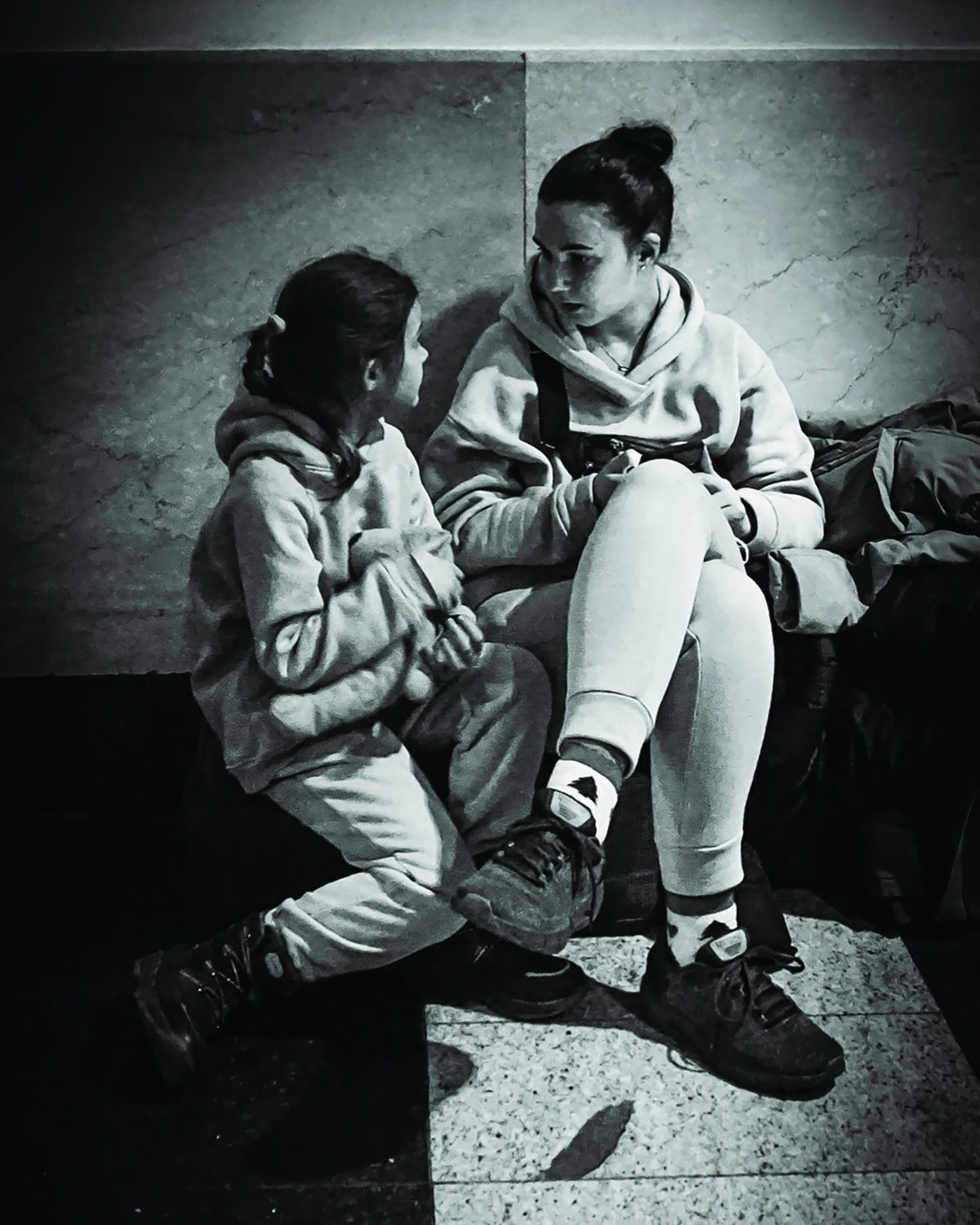
I held my wife’s hand the whole way to the airport.
We’d talked about this for weeks. But now that the day was upon us at last, it felt wrong. I questioned my decision. Had I made it too early? Was I overreacting to unfolding events? I felt less sure of my convictions the closer we came to saying goodbye.
But what was the harm in her leaving for a few weeks? Better to go now, I considered, while all the airlines were still operating. There were plenty of skeptics, particularly among my American friends at the US embassy in Kyiv. They thought the Russian buildup was all a bluff and that I was being overdramatic. Fair enough, I suppose. But by the beginning of February, I’d concluded the evidence pointed toward Russia launching a major military operation. I couldn’t ignore it.
My wife and I agreed on her departure after Russia began its massive military buildup in Belarus, raising the risk of an attack on Kyiv. To her credit, Lilly didn’t want to go. But she supported my suggestion, as well as my desire to stay behind to give the Ukrainian people — the victims — a voice in this terrible chapter in history.
Lilly handled the whole situation with grace. And that’s saying something because her 57-year-old father, a Soviet army veteran, had decided to enlist as a member of his hometown’s territorial defense battalion. Lilly’s mother couldn’t evacuate without losing her job, so she chose to stay behind as well. Lilly didn’t want to go, either. But she did it for me.

The departure hall at Kyiv’s Boryspil International Airport was less crowded than usual, but the place seemed normal. The normality further fueled my self-doubt. I felt a little silly. No way a war could come here, I thought. I mean, come on, this is a European capital. We have McDonald’s restaurants and Nike Town stores and speakeasy bars and CrossFit gyms, and Apple TV in our living rooms. You’re being dramatic, the intellectual side of me said.
And yet a dark warning emanated from the reptilian part of my brain. Like a chill down the spine when standing at the edge of a cliff or the pulse of adrenaline at the S-shape of a slithering snake — some unexplainable, ancient alertness to danger warned me that normal life was the illusion. War was the reality.
After check-in, we walked to the security checkpoint. We’d made a firm decision days earlier while under more emotionally sober circumstances. Now, momentum was doing all the work. We gave in to gravity and went as far together as we could.
My wife and I embraced, and the whole world swirled around us at a half-beat faster rhythm than our own. We held each other a moment, holding in place the one thing we could. I kissed her, and we pressed our foreheads together and spoke in the space between. I said I loved her and that I would be safe. I promised we would see each other again soon.
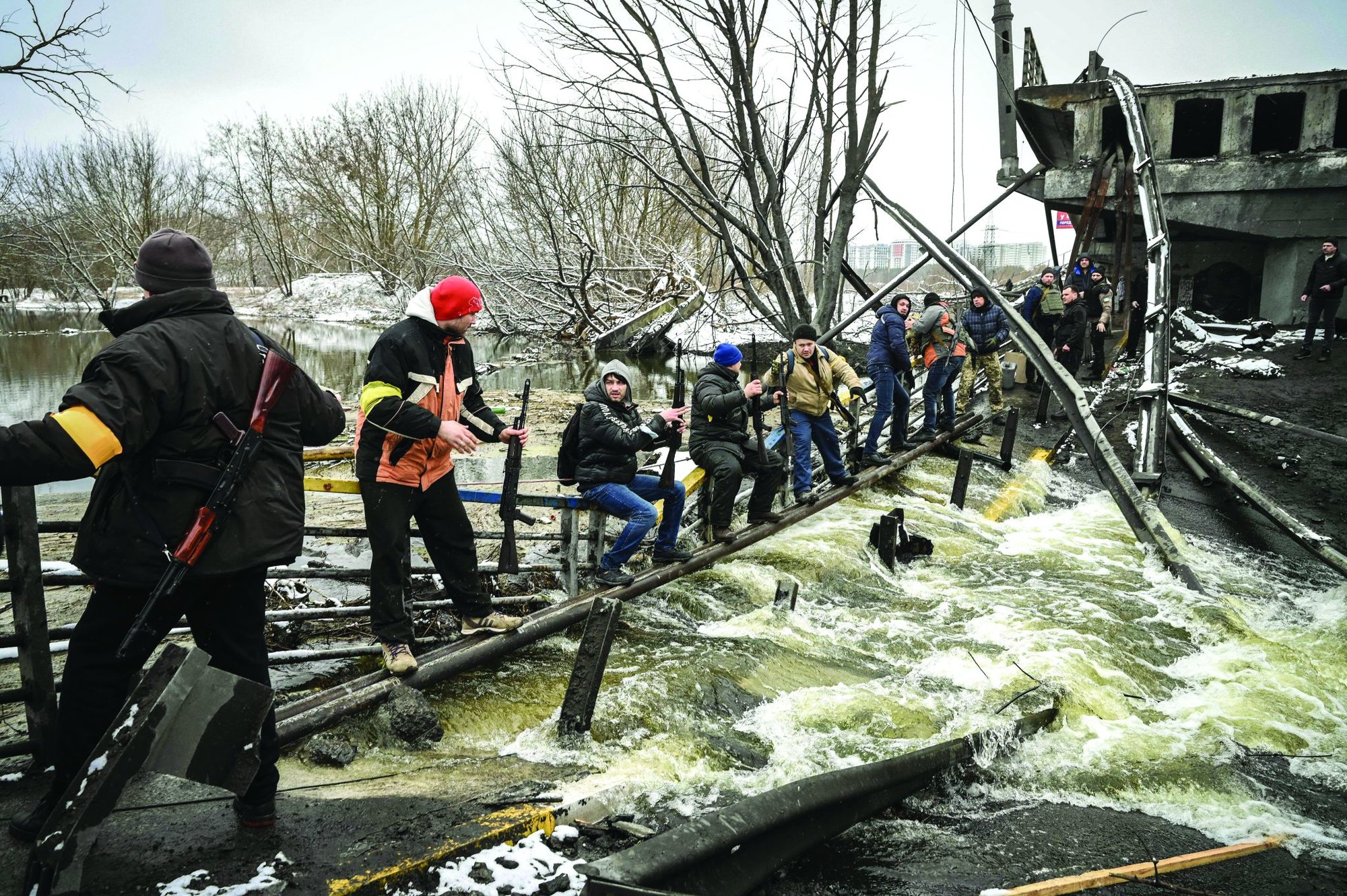
And then she was gone, and I was alone. Hers was a one-way ticket, and it ripped my heart out to see her go. I did not know where and under what circumstances we would meet again.
How many people in Ukraine had to say a similar goodbye in those few weeks leading up to the invasion? How many children had to hug their father one more time, then leave him behind at the train station as Russian missiles rained down on the city? How many unknowingly said goodbye for the final time?
What war does, that dirty crook…
Above all, it steals our time together.
I had been in Ukraine for nearly eight years before the invasion to report on the war in the Donbas — where, along an entrenched front line, Ukrainian troops had been in constant combat against Russian forces since the spring of 2014. The combat I experienced in the war’s early years exceeded the intensity of anything I observed in Iraq and Afghanistan — both as an Air Force special operations pilot and later as a conflict journalist. Artillery barrages, rocket attacks, tank combat, snipers and trench war, and even a civilian airliner shot from the sky. It was terrifying stuff.
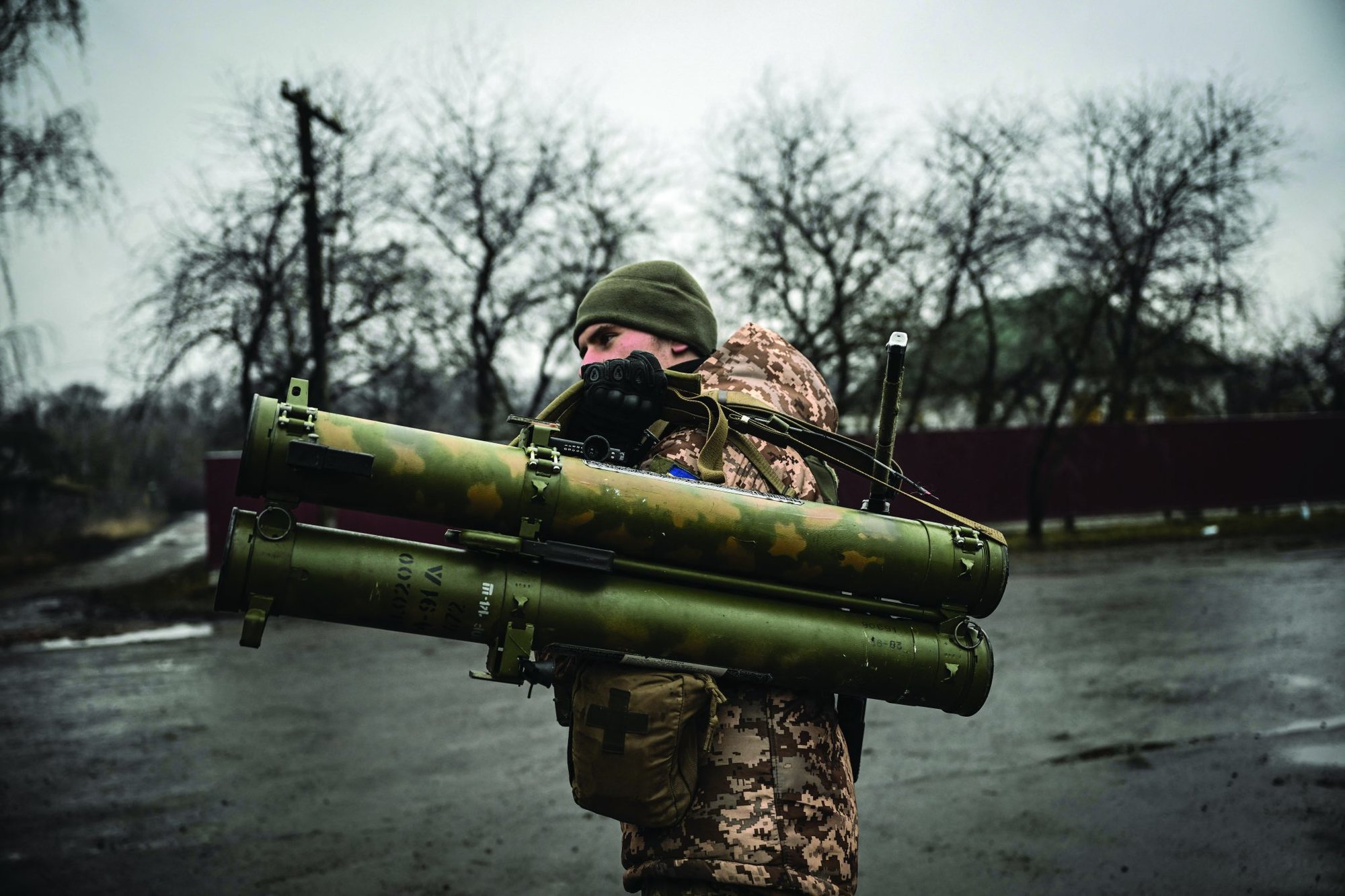
By invading the Donbas, Moscow likely intended to reverse the outcome of Ukraine’s 2014 pro-democratic revolution in a bid to preserve Russia’s Soviet-era empire of influence. The Kremlin assumed that its unconventional blitzkrieg would break Ukraine’s civil society and cause the country to unravel from within. But Ukraine’s citizens — its young adults, in particular — proved to be much more resilient than Moscow had anticipated.
For Ukraine’s millennials, the Soviet Union is a secondhand memory. Too young to comprehend the perils of the 1990s, they grew up watching American movies and experiencing Western culture by proxy through social media and the internet. Consequently, the country’s younger generations remained hopeful that their lives would improve, and hope had been the catalyst for turbocharged social and political changes since the war began.
In those early months of the war, Ukraine’s regular army, which remained depleted in manpower and equipment after decades of post-Soviet corruption, could muster no more than a few thousand combat-ready soldiers. Thus, with the regular army on its heels and the threat from Russia ever increasing, a nationwide, grassroots resistance movement took shape. It was a spontaneous manifestation of Ukrainian civil society, underscoring a widespread attitude of self-reliance among citizens who were unwilling to wait for the government to act in a moment of crisis.

Whatever formed their individual inclinations, something extraordinary had to have taken root in the soul of each man and woman who volunteered for war on Ukraine’s behalf. I know from experience how terrifying it is to advance toward the sounds of gunfire or an artillery cannonade; one must be motivated by something more powerful than the fear of death to do it.
Following a February 2015 cease-fire, the war froze into a stalemate. Since then, the parallel existence of ordinary life and combat had become the war’s most jarring characteristic. You could have McDonald’s for dinner in Kyiv, take the overnight train to Avdiivka, and hear the sounds of artillery from the nearby front lines rumbling in the background by morning. That transition from war to peace was even more severe in cities like Mariupol, where everyday life carried on within earshot of the front lines.
War, in a sense, had become part of the regular background din of life in Ukraine. Although large-scale combat loomed like the sword of Damocles over the country, threatening to escalate beyond the Donbas at any moment, Ukrainians adapted to the danger. Even in the front-line city of Avdiivka, which occasionally suffered from wayward Russian shells, outdoor markets remained open, and children still went to school. There were still weddings, birthdays, funerals, and other ebbs and flows of ordinary life. But the storm of war was still there, just over the horizon, ready to strike at any moment.
That’s one thing that war, even the threat of it, does. It turns the utterly banal, everyday trappings of life into extraordinary expressions of grace under pressure.
Facing the prospect of a far more extensive and deadlier conflict, volunteer groups trained civilians in combat first aid, how to pack go-bags, where to find the nearest bomb shelters, and how to take care of children in a combat environment. It was remarkable to watch, really. Ukraine’s civil society stepped up to the plate and prepared for war. They — once again — did not wait for the government to save them.
Today, as the Ukrainian military continues to fight ferociously on the field of battle, the fruits of their preparation are evident. The whole world watches as the Ukrainian nation delivers a master class in how a democratic society should act in a moment of crisis. It’s hard to turn back the clock once you’ve sowed the expectation of freedom within a nation’s mind.
Eleven a.m. on a Tuesday morning is a time for adults to be at work and kids in school. But not that day. On the cold morning of Feb. 8, about two dozen Ukrainian civilians, ranging in age from 13 to 60, stood in formation on a snow-covered field in an industrial area on the outskirts of Kyiv. They were clad in a mishmash of old army uniforms and outdoor gear. They wore running shoes and hiking boots. Some held wooden facsimiles of Kalashnikovs; others brought their hunting weapons. They’d gathered at the base of the Georgian National Legion, a unit of foreign fighters who volunteered to fight for Ukraine.
Before Russia invaded, the legion organized courses in basic military skills for some of Kyiv’s civilians to learn the fundamentals of marksmanship and more. Several times a week, for several hours per stretch, these civilians ran through individual movement drills, including how to take cover from artillery and airstrikes and lessons in small unit tactics. Their repeated presence at these drills offered clear evidence of the Ukrainians’ spirit of resistance. These were not weekend warriors or wannabe soldiers. These were people who wanted to protect their families.

Leading that day’s drills was Adam, a 25-year-old former US Army Ranger and combat veteran of the war in Afghanistan. Standing nearby was Paul, an Army combat veteran of Iraq who served in the 101st Airborne Division. Adam and Paul fought against insurgencies in Iraq and Afghanistan. These two American combat veterans were tasked with training Ukrainian civilians to wage an insurgency of their own against a potential Russian occupation force. Both men also believed that it was their moral duty to help Ukrainians defend their freedom and their lives should Russia attack.
The trainees sprinted from position to position with the unquestioning commitment of recruits in basic training — even though many were in their 40s or older and past their physical primes. By Adam’s account, they picked up his lessons quickly. The civilians’ commitment to military training made a powerful impression on the American veteran. Particularly the presence of a 13-year-old boy named Oleg. Hours later, at dinner, Adam stared into his beer and explained that the sight of Oleg training for war had laid bare the potential for human tragedy during a Russian attack.
“He just looked so young,” Adam said. “That kid should be out playing with his friends, not getting ready for a Russian invasion.”
On that night, Paul, Adam, and I met at a pizza restaurant in central Kyiv with other members of the Georgian National Legion. We ate well and shared a few beers, trading stories of the wars we’d all been to. As the night moved on and drinks flowed, we began to more overtly express the thoughts that had been spinning like cyclotrons within our minds. Above all, what would we do if Russia attacked Kyiv?
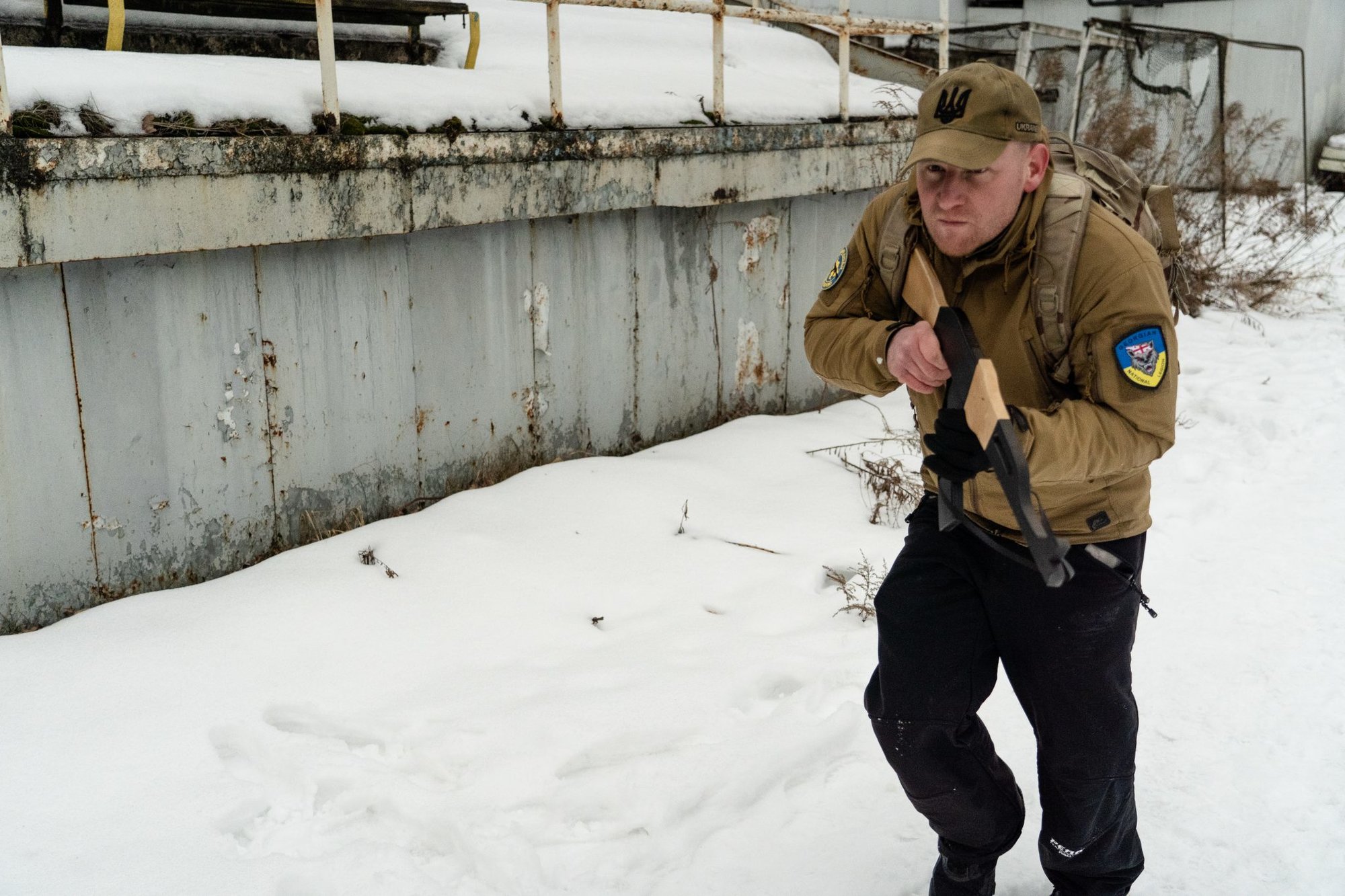
Paul, who had lived in Ukraine for 15 months already, explained that many of his Ukrainian friends were asking him what to do — stay, flee, or fight? For his part, Paul was ready to defend his adopted hometown should Russia attack. Adam, too, was willing to take up arms, should the worst come to pass. Both men knew that this wasn’t their war. But defending innocent civilians is a universal obligation, both men believed, for people like themselves who have the skills and the spirit to fight.
As the night wore on and the alcohol caught up, the absurdity of the whole situation was not lost on me or any of us. There we were in a European capital in 2022, making plans for a World War II-style siege. Adam, who had only been in the country for two days by this point, displayed a wide-eyed look at times as if his mind were asking, What the hell did I just walk into?
We discussed plans to buy radios and stock up on food, water, and first-aid kits. I invited Paul and Adam to live with me if the Russians attacked the city — strength in numbers, right? They agreed.
We left the bar and stepped into the cold night. Friendship, camaraderie, companionship — these things hit harder and become as essential as oxygen when the trappings of civilization seem ready to collapse. At the precipice of disaster, the most common and powerful human emotion is, I believe, a desire not to be alone. To seek comfort in companionship, to share your story with those around you. And, of course, to laugh.
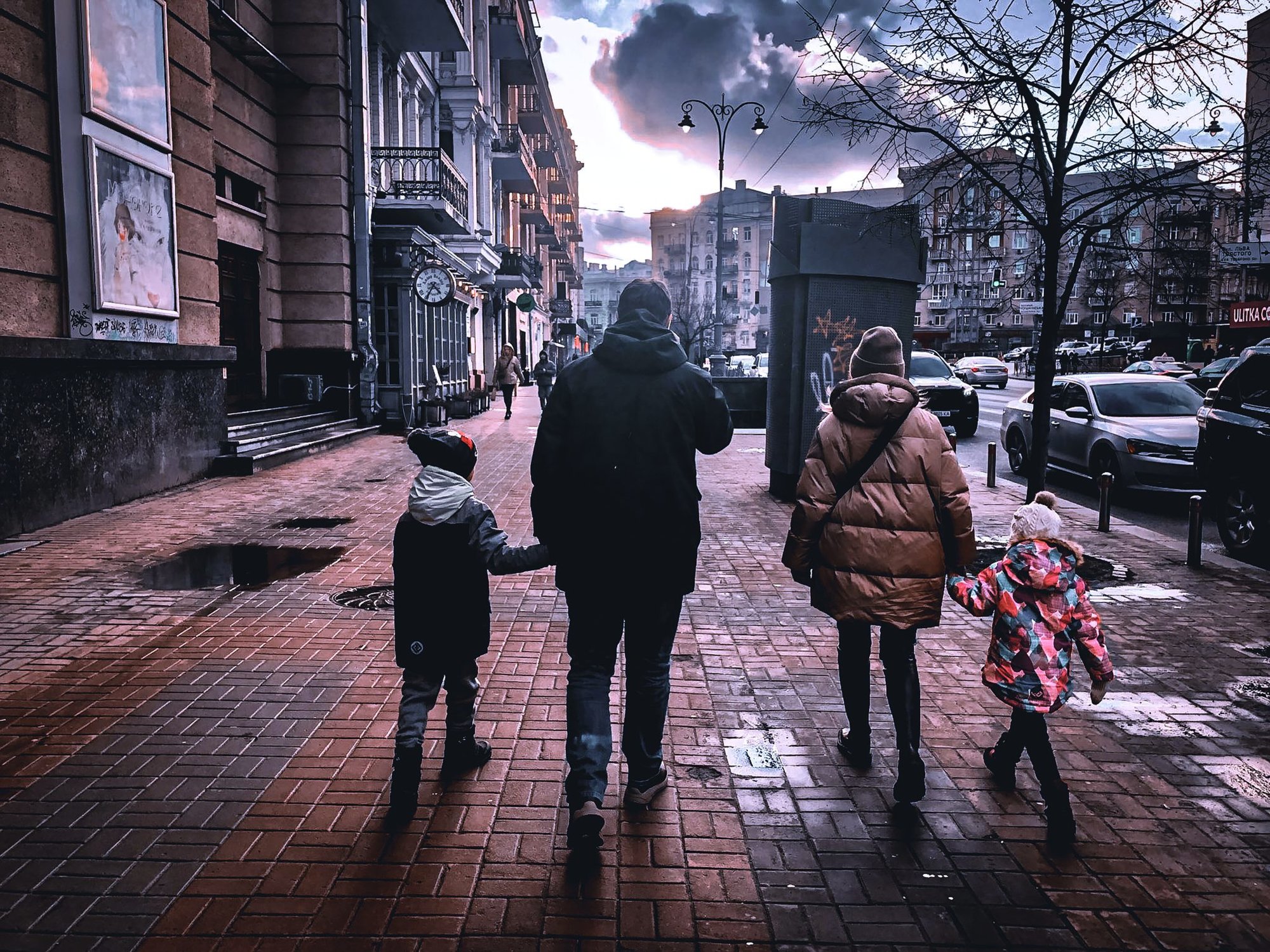
A laugh, a slap on the back, a shot of some stiff drink — all these things divorced us from our reality, if only for a moment. But when that night ended with the rise of a sober sun, the full weight of the moment descended on me again. I felt very sad for all the people living here. Their worst fears were about to come true.
About 100 yards from the ground-level entrance to my apartment building, there lies an underground pedestrian passageway. Before the Russians invaded, I walked each day through the stone-walled, Soviet-era underground arcade on my way to and from wherever. And at the same time each evening, a musical duo was invariably positioned against one wall playing their eclectic set of music. As the war clouds drew in, the presence of those musicians and the beauty of the music they played evolved from being part of the background din of day-to-day living. They became an extraordinary example of the ability of human beings to endure. That’s one thing that war, even the threat of it, does. It turns the utterly banal, everyday trappings of life into extraordinary expressions of grace under pressure.
Two musicians — a woman on violin and a man on accordion. It was such a simple, beautiful thing. Yet, based on their notes’ emotional impact, that underground passageway could have been a front-row seat to see Yo-Yo Ma at Carnegie Hall. The music they played was crisp and clear in the frigid winter air. The corridor connected to a nearby metro station, and a steady stream of people always passed by at the workday’s end. People went about their daily lives bundled up for the winter cold. Despite the hustle of life in the big city, a few people usually gathered near the musicians. They stood there, pausing their life a moment to listen. Then they’d drop some change into the musicians’ collection box and move on.
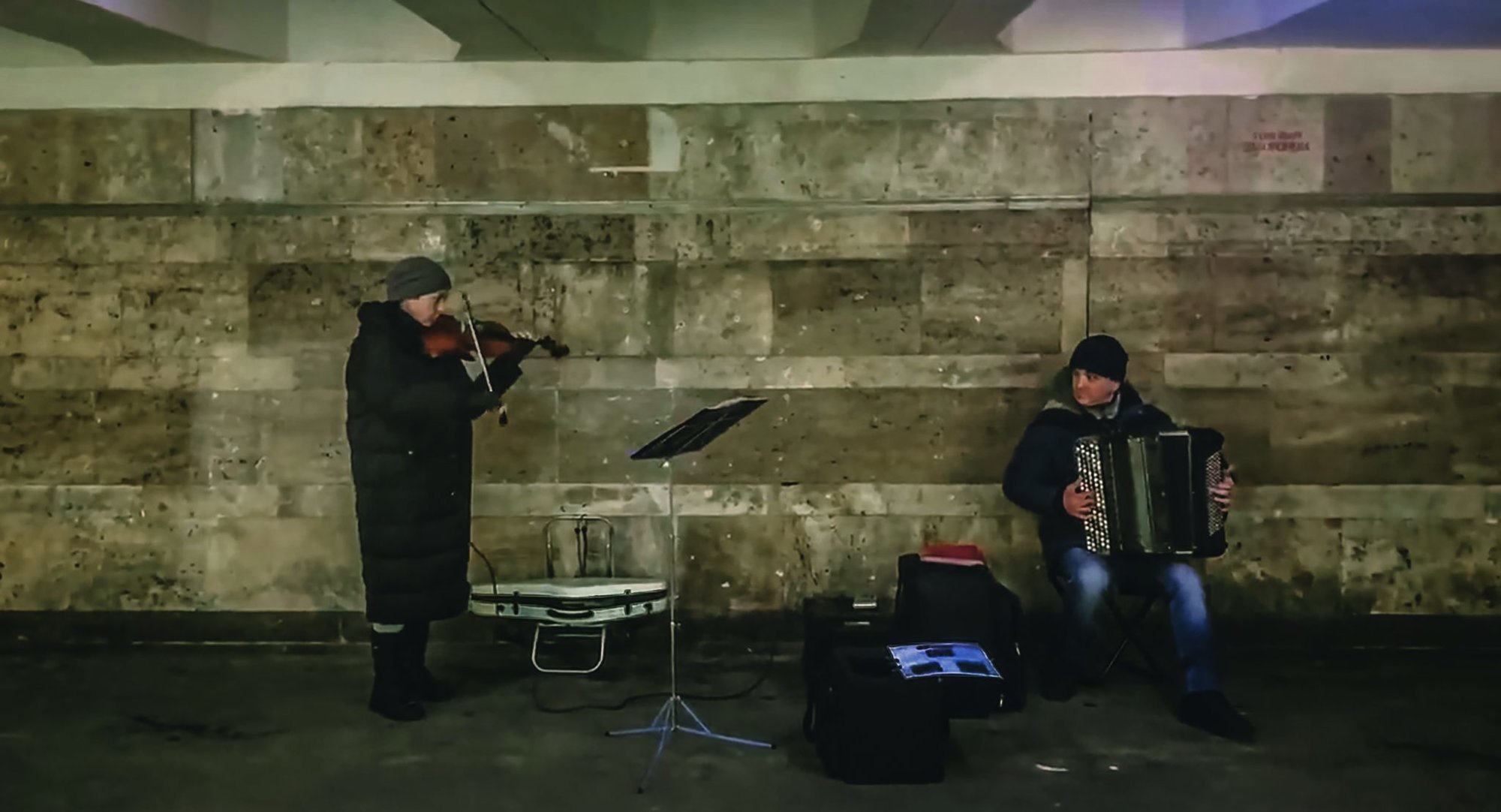
As the threat of a Russian invasion cast a darker shadow over our lives, I noticed a peculiar but striking change among the people who stood aside to watch those musicians play. They began to make eye contact more often and more freely. Maybe it was a small thing, even a bit imagined. Perhaps I craved a connection with the people around me.
On the evening of Saturday, Feb. 12, the day the US and a score of other foreign embassies announced their evacuations, I was on my way to grab groceries when, as was my habit, I paused to listen to the musicians play. They began a classical rendition of “Zhuravli” by the Ukrainian rock band The Hardkiss. The pulsing, rising, and falling pace and tone of the song caught me off guard. Suddenly, I saw everything under the shadow of war. The mother holding her daughter’s hand. A group of teenagers smoking, talking, laughing. A young couple embracing. The older man shuffling by with his hands held behind his back. I saw all this, and a mountain of rage and sadness and aimless energy rose within me.
With my back against the wall, I took out my iPhone and began to record. And then it started. It rose from my chest slowly at first, and I tried to control it but could not. So I cried. I cried for the past eight years. For all the suffering I’d seen and all the brave people I’d met. I cried because I missed my wife, because I wanted her to have a homeland to come back to. I cried because of Daniel, a 19-year-old soldier who had been my friend and had died in battle years ago. I cried for the thousands of other Ukrainians who have suffered in their war for freedom. I cried because their war wasn’t over. It was only just beginning.
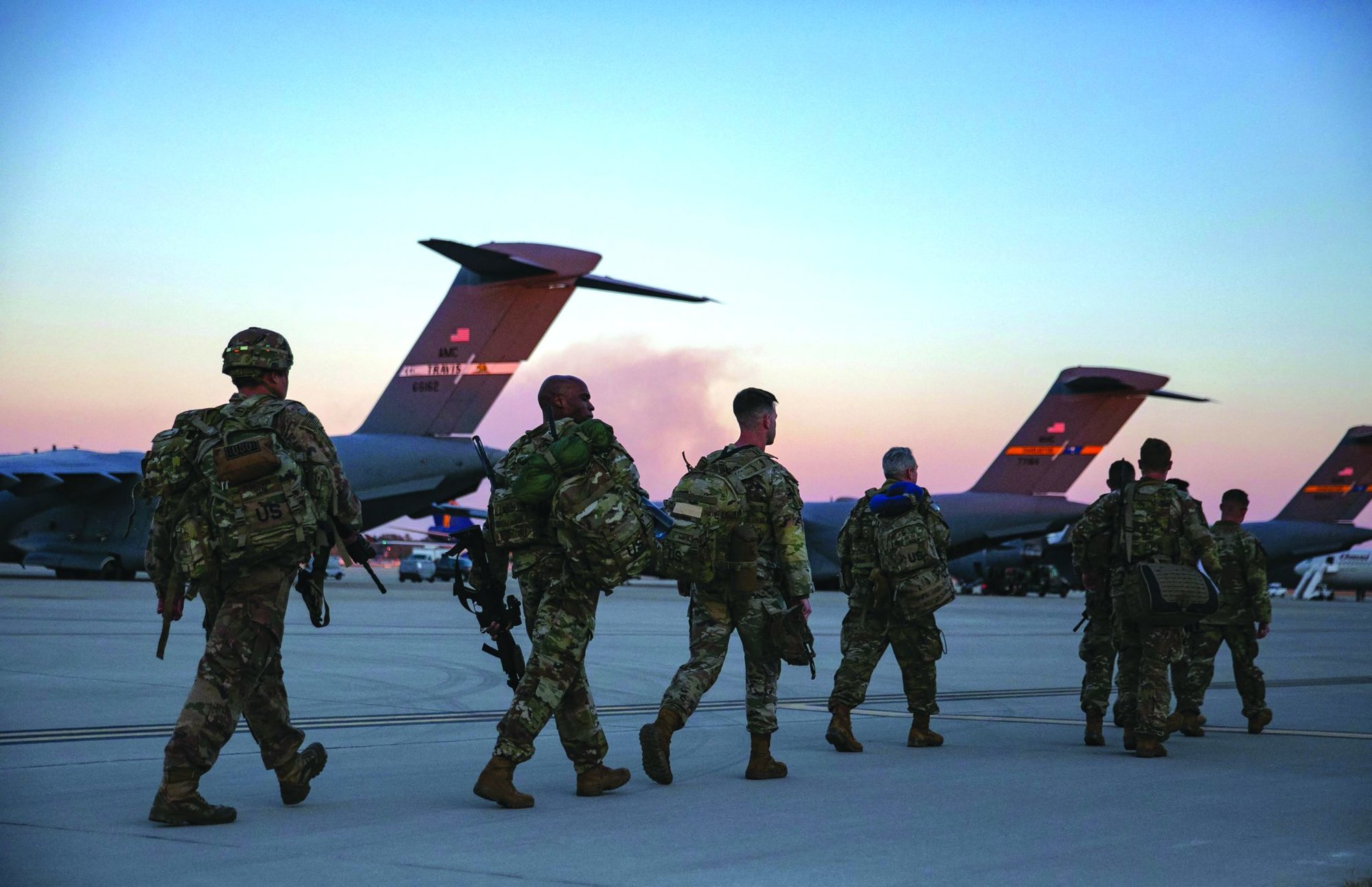
You, dear reader, watched all the wishful thinking that aimed to dismiss the Russian buildup as a bluff disappear in the opening salvo of missiles that struck Kyiv on Feb. 24. The tanks, artillery, ballistic missiles, multiple-launch rocket systems, electronic warfare systems, attack helicopters, warplanes, and tens of thousands of soldiers crossed the border from staging areas and forward positions along dozens of miles of Ukraine’s borders. This war is no longer a distant thought, but a violent reality.
The US government and many others cleared out their embassies, and international air travel came to a halt. The relative calm and “life goes on” sang-froid within Kyiv, which had so stupefied all the foreign journalists, cracked and gave way to making Molotov cocktails and taking cover in subways. As I write this, the westbound exodus of civilians continues as Kyiv is surrounded by Russian forces. Men ages 18 to 60 are forbidden from leaving — their nation needs them on the front lines.
Many of my friends bought body armor and radios, which have no doubt become invaluable lifesaving pieces of equipment. One friend, who is part of an underground resistance cell, had invested thousands of his own dollars into converting his car into a mobile radio communications relay post.
My friends in the Georgian National Legion relocated to a defensive line just north of Kyiv’s city limits. I fear for their survival. Courage, of which they have plenty, counts for little against an airstrike or an Iskander missile. Despite the overwhelming odds stacked against them, and the relentless shelling of military and civilian targets alike, Kyiv still stands as I write this.

I made plan after plan about what I would do in different situations. But it was all an academic exercise. And it was all sort of bullshit, to be honest. In truth, no one knows what to do in this situation. Not really. Anyhow, I’m still here. My friends and I banded together for safety, and I’ll continue to report for as long as I can. If the Russians take Kyiv, I’ll do my best to get out of the country. And when this is all said and done, Lilly and I plan to reunite in Florida. I look forward to a long vacation and lots of heavy drinking; I have one hell of a story to tell.
In the summer of 2014, I had a one-way plane ticket to Ukraine. I left to report on the war, thinking I’d only be gone for about two weeks. I didn’t even check a bag.
By the time the plane landed in Kyiv, I was in a serious state of mind. Hyperaware of details, I observed my new surroundings from the back seat of a taxi on the drive into the city center. The sounds of the language through the radio, the microcosms of day-to-day life on the side of the road. The styles of buildings, the makes of the cars, the products advertised on billboards. I registered it all. But there was something unseen lurking behind every vignette. A hidden presence that framed every novel observation.
It was the war, even though there wasn’t a single clue to its presence. Not yet, at least.
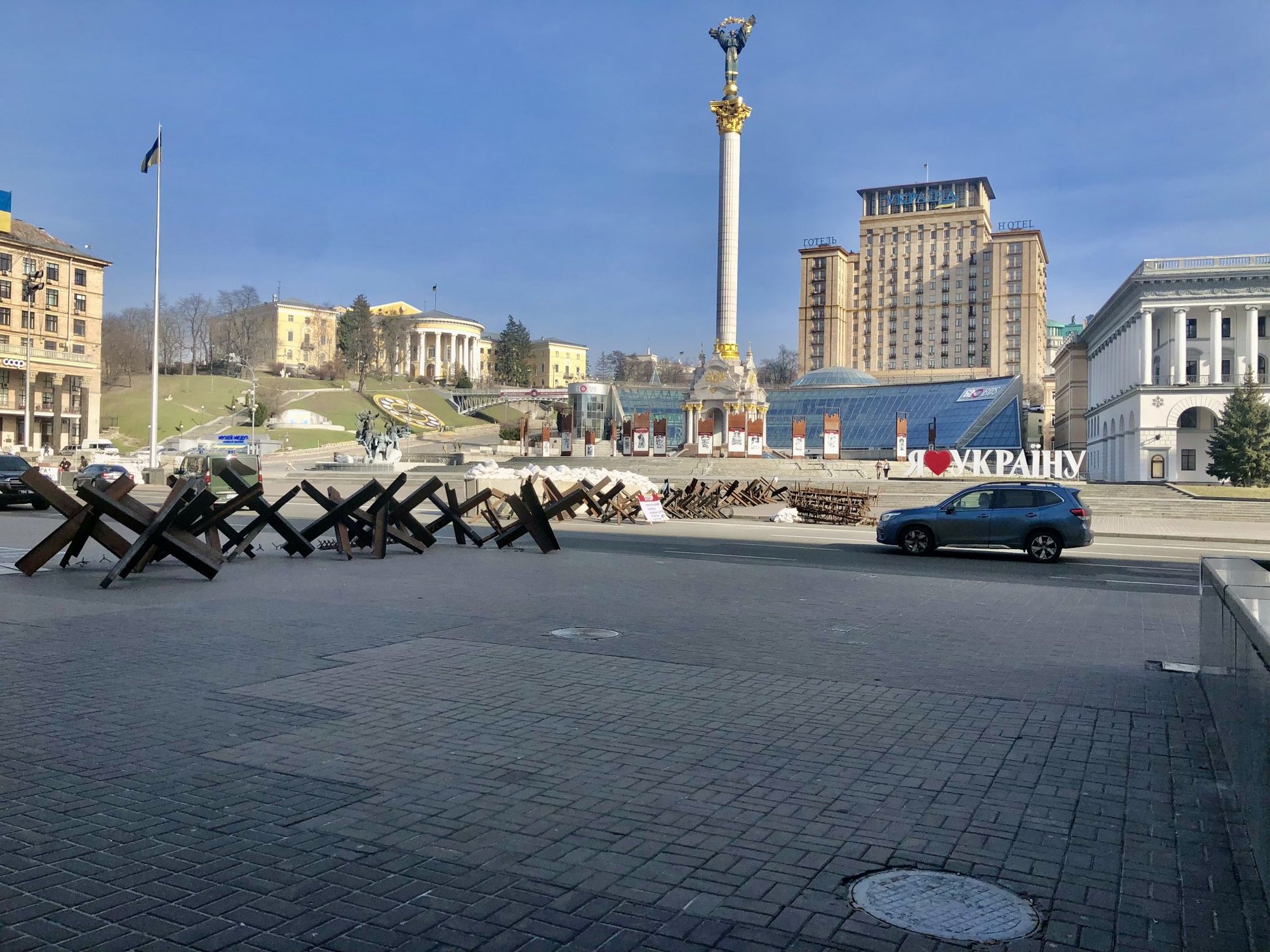
The taxi deposited me in Kyiv’s city center at the top of Institutskaya Street, as it was still called at the time. Today, it’s named Heroes of the Heavenly Hundred Street, in honor of the roughly 100 protesters who died in the February 2014 revolution. On that warm summer day, trees lined the cobblestone street as it steeply ascended from the Maidan, Kyiv’s central square and the epicenter of those pivotal events. Young couples in shorts and flip-flops walked past holding hands. Police officers on their beats were relaxed, smiling and joking. Yet, beneath the veneer of what could have been a typical summer day in any European capital, there were reminders of what happened there during the revolution’s final days.
Bullet holes pockmarked the street signs and trees. An arrangement of framed photos was spread over the ground, surrounded by flowers and candles. The photos were of the fallen — men and women, old and young — everyday people. I scanned these faces and wondered what had inspired them to be so brave.
Of all the sights and sounds I encountered that day, one stood out above all others. It was a voice in English, so my ears naturally homed in on the understandable words.
“Freedom isn’t free,” the voice said.
Since that day, I’ve had an eight-year education in what those words truly mean. And now, as I witness an unthinkable disaster unfold around me, Ukrainians still believe that their dreams of freedom and democracy are worth fighting for — no matter what it costs them.
The whole world needs to hear that message as they watch Ukraine, quietly asking themselves, “Is this our next war?”
This article first appeared in the Spring 2022 edition of Coffee or Die’s print magazine as “America’s Next War?”
Read Next:

BRCC and Bad Moon Print Press team up for an exclusive, limited-edition T-shirt design!
BRCC partners with Team Room Design for an exclusive T-shirt release!
Thirty Seconds Out has partnered with BRCC for an exclusive shirt design invoking the God of Winter.
Lucas O'Hara of Grizzly Forge has teamed up with BRCC for a badass, exclusive Shirt Club T-shirt design featuring his most popular knife and tiomahawk.
Coffee or Die sits down with one of the graphic designers behind Black Rifle Coffee's signature look and vibe.
Biden will award the Medal of Honor to a Vietnam War Army helicopter pilot who risked his life to save a reconnaissance team from almost certain death.
Ever wonder how much Jack Mandaville would f*ck sh*t up if he went back in time? The American Revolution didn't even see him coming.
A nearly 200-year-old West Point time capsule that at first appeared to yield little more than dust contains hidden treasure, the US Military Academy said.












